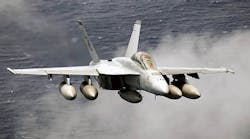Raytheon and DARPA consider deploying unmanned air and marine vehicles from fighter aircraft
Scientists at the U.S. Defense Advanced Research Projects Agency (DARPA) in Arlington, Va., are asking engineers at the Raytheon Co. Missile Systems segment in Tucson, Ariz., to come up with a preliminary design for launching unmanned aerial vehicles (UAVs) and unmanned underwater vehicles (UUVs) from the Navy carrier-based F/A-18 Hornet fighter-bomber.
The idea is to use attachments on the underside of the F/A-18 where auxiliary fuel tanks normally go. This approach, if successful, would give Navy commanders a fast and long-range capability to deploy unmanned surveillance aircraft and submersibles when time is of the essence.
DARPA awarded a $284,640 study contract to Raytheon Missile Systems earlier this month to focus on a preliminary design for a base station for UAVs and UUVs on an F/A-18 fuel tank underwing hard point.
Related: DARPA considers unmanned submersible mothership designed to deploy UAVs and UUVs
DARPA researchers want Raytheon to evaluate enabling technologies for deploying UAVs and UUVs from F/A-18 combat jets in variable seas, define potential mission profile for UAV and UUV deployment from jet fighters, and consider power, communications, and surveillance payloads for fighter-deployed drones.
DARPA is trying to help Navy commanders find new ways to provide long-range persistent surveillance in forward deployed maritime areas. This concept capitalizes on the speed and responsiveness of aircraft with the persistence of a maritime platform, DARPA officials say.
If successful, air delivery will force the drone payloads to survive the force of entering the water from a relatively high-speed aircraft like the F/A-18.
Raytheon has expertise in designing missiles and other munitions for delivery from high-performance military jets. The company's Integrated Defense Systems segment in Keyport, Wash., also produces the Navy's MK 54 MAKO Lightweight Torpedo, which can be launched from aircraft.
Related: DARPA readies program to enable unmanned aircraft to share information and work together
The F/A-18F Super Hornet can fly at nearly twice the speed of sound, and has a combat radius of 630 miles. The jet can carry a variety of bombs and missiles, including the Boeing Standoff Land Attack Missile Expanded Response (SLAM-ER).
The SLAM-ER missile is 14.3 feet long, 13 inches in diameter, and weighs 1,487 pounds. The MK 54 torpedo, by contrast, is nine feet long, 12.75 inches in diameter, and weighs 608 pounds. For comparison, a Bluefin-21 UUV from Bluefin Robotics in Quincy, Mass., is 16.2 feet long, 21 inches in diameter, and weighs 1,650 pounds.
The Boeing F/A-18E/F Super Hornet is a twin-engine carrier-based multirole fighter aircraft with an internal 20-millimeter M61 rotary cannon and the ability to carry air-to-air missiles and air-to-surface weapons.
Additional the F/A-18E/F can carry fuel in as many as five external fuel tanks and the aircraft can be configured as an airborne tanker by adding an external air refueling system.
For more information contact Raytheon Missile Systems online at www.raytheon.com, or DARPA at www.darpa.mil.
